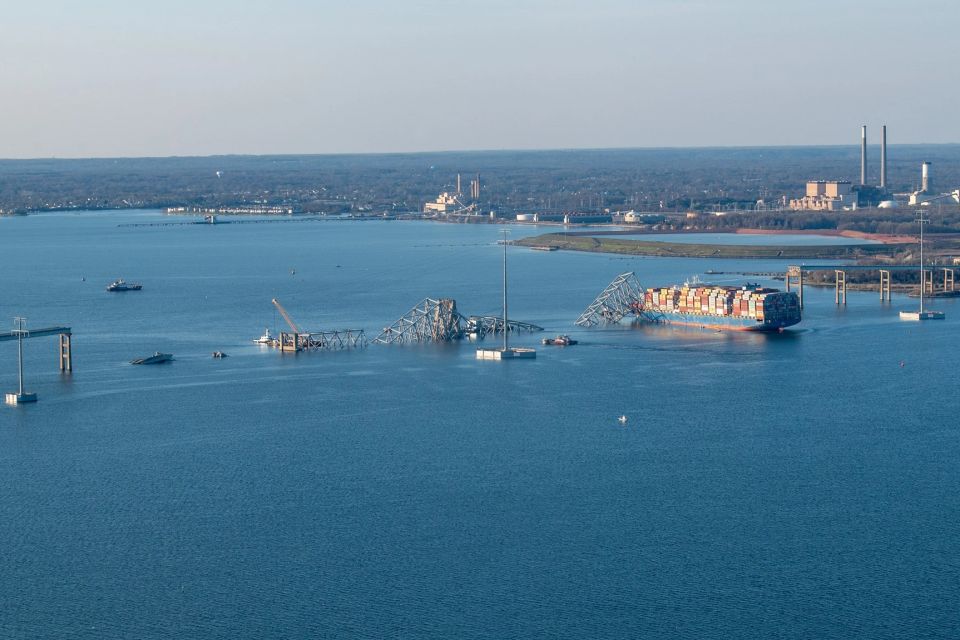The tugboat Crystal Coast pushing a fuel barge transited the temporary alternate channel created by the Key Bridge Response Unified Command, at 3 p.m. (local time) on Monday, 1 April. It is the first vessel to use the channel since the bridge collapsed into the federal waterway on Tuesday, 26 March. On 2 April, a second channel opened.
The barge is used to supply jet fuel to the Department of Defence (DOD) and was transiting to Dover Air Force Base.
The Captain of the Port (COTP) established the temporary alternate channel near Sollers Point for commercially-essential vessels. The temporary channel is on the northeast side of the main ship channel in the vicinity of the Francis Scott Key Bridge. This action is part of a phased approach to opening the main federal channel.
This new temporary channel is marked with government-lighted aids to navigation. It will be limited for transit at the discretion of the COTP and during daylight hours only. This temporary channel has a controlling depth of 11 feet (3.35 metres), a 264-foot (81.69-metre) horizontal clearance, and vertical clearance of 95 feet (28.96 metres).
Also read: Baltimore bridge collapse may cause supply chain disruption
UPDATE 2 APRIL: Second temporary channel opened
The Captain of the Port (COTP) established a second temporary alternate channel on the southwest side of the main channel near Hawkins Point in the vicinity of the Francis Scott Key Bridge for commercially essential vessels.
This action is part of a phased approach to opening the main channel. The second temporary channel is marked with government lighted aids to navigation and will be limited to transit at the discretion of the COTP and during daylight hours only. It has a controlling depth of 14 feet (4.27 metres), a 280-foot (85.34-metre) horizontal clearance, and a vertical clearance of 124 feet (37.8 metres).
‘The opening of these two alternate channels and transit of critical response resources, as well as the first commercial traffic movements through the area, is a significant milestone in our response efforts,’ says US Coast Guard Cmdr. Baxter Smoak, operations section chief of the Key Bridge Response 2024. ‘Our number one priority remains the opening of the deep draft channel. We are simultaneously focused on opening additional routes of increased capacity as we move forward.’
Bridge removal
Two crane barges, a 650-tonne crane and a 330-tonne crane, are actively working on scene. Wreckage will continue to be lifted and transferred to a barge as daylight allows.

A 230-tonne land-based crane will offload and process the wreckage at Tradepoint Atlantic, which will then be taken to a disposal site.
Safety zone
The current 2000-yard (1828.8-metre) safety zone around the Francis Scott Key Bridge remains in effect and is intended to protect personnel, vessels, and the marine environment. Members of the public may not enter the safety zone unless authorised by the COTP or designated representative. Those in the safety zone must comply with all lawful orders or directions given to them by the COTP or designated representative.
The COTP issued a Broadcast Notice to Mariners (BNM) via VHF-FM marine channel 16. Mariners are requested to monitor channel 16 for the latest information. A Debris Reporting Hotline has been established.
Also read: VIDEO: Bridge collapses after being hit by container ship
Unified Command
The Key Bridge Response 2024 Unified Command includes the:
- US Coast Guard
- US Army Corps of Engineers
- Maryland Department of the Environment
- Maryland Transportation Authority
- Maryland State Police
- Witt O’Brien’s representing Synergy Marine
The Unified Command’s operational priorities are ensuring the safety of the public and first responders, accountability of missing persons, safely restoring transportation infrastructure and commerce, protecting the environment, and supporting the investigation.
Picture (top): The M/V Dali is shown with the collapsed Francis Scott Key Bridge on March 30, 2024, in Baltimore (US Coast Guard photo by Petty Officer 3rd Class Kimberly Reaves).








